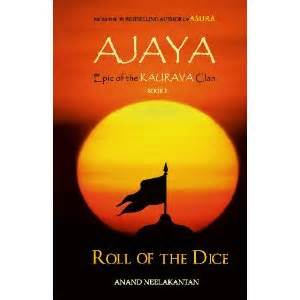Starting with the review, it’ll be important to familiarize yourself with the following:
- More of a descriptive take, rather than to conjure up a story with dialogues.
- Not a good feeling while reading this novel knowing that the good guys were actually the bad guys.
- The whole concept of Pandavas being bastards is like a spitting in the face. Kunti is shown in bad light as the author says she has to go to bed with 3 different men, with the permission of her husband. Same is the case with Madri.
As the major characters like Krishna and Pandavas have been stained with cruel background stories, it is baffling to tell whether the author actually has respect for the good things ensued after Mahabharata or not. - Purity of body and spirit can always be read in almost every chapter. And Pandavas and the Brahmins are seen cursing the untouchables and reminding themselves of purifying their body and spirit. But what the author was trying to say was maybe they were so immersed into getting the scriptures in to their lives that they wholly forgot the sole reason of existence of the same. That, purity of mind never crossed their mind. That is what should be taken from this context.
- Author’s views on Pandavas genetic fathers, Draupadi’s marriage- even time period with every husband is wrong. Its 6 months rather than one year as mentioned in the novel. But that can be understood, after all it’s a novel. But the author doesn’t wait doing just that. He says Kunti “permits” only Bhima to marry a rakshasi (in other words; a demon) because Bhima himself was born from a forest dweller, when the good old pages of Mahabharata say otherwise. He writes that, when he overlooks the incidents behind the story of this marriage.
Bhima fights his opponent, Hidimba; a rakshas and kills him. Long story short he has to marry the rakshasa’s sister Hidimbaa. The author couldn’t even get the spelling right. (He made it, Hidumbi. Also, making Yudhishtra as against Yudhishtir)
- Anand falls madly in love of the Kauravas. The gamut of his obstinacy or blasphemy (whichever it is) is so wide that he creates a story where all Suyodhana does is good and all the Pandavas do is bad.
So as to speak honestly, such novels with their crazy ideas are changing the course of history, mythology and everything we believe in. Such books will affect the youngsters the most, for youngsters will place them as ideals because of the fanciness of the storytelling & alterations in the these holy stories, and those will be the words they’ll breath.
These books inevitably will destroy everything we (Hindu’s) believe in.
- The author mentions in intro that he is attracted towards villains. It doesn’t matter if he shows Suyodhana as a good person, it is provocative when Pandavas and Krishna are displayed as being cruel, manipulative of the dharma and the scriptures, when they were not.
The Final Word:
Anand Neelkanthan is a good writer, but he makes damn difficult to judge his book. The story does not have any importance, first because it is exactly opposite of Mahabharata and secondly because of the nasty feature of Pandavas and Krishna. But, yes, he has somehow come on top to contrive his story because of his knack of storytelling. But when a battle scene comes, I always drift on to this thought that, “Amish Tripathi would’ve done so much more with them.” He depicts battle scenes like how Sanjaya; the secretary and commentator of blind king Dhritarashtra would have described. But apart from that, amidst the mess he created, his work can be read. For this particular novel, the gaffes surpass the goodies. I’ll go with 1.5/5 for the distress that it is.
It’s vital whose story you tell, but it’s pivotal how you tell it.
For fools are we, for buying such books and a fool is he for believing every word he’s writing.
